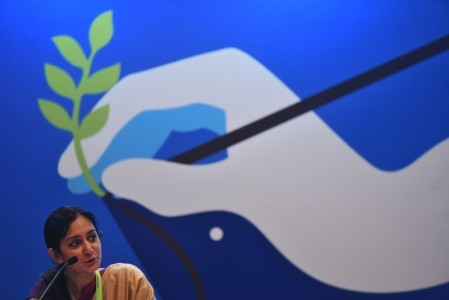Popular Reads
Top Results
Can't find what you're looking for?
View all search resultsPopular Reads
Top Results
Can't find what you're looking for?
View all search resultsJournalists’ safety in spotlight on press day
Change text size
Gift Premium Articles
to Anyone
A
t a time when global press freedom is threatened, placing journalists at risk even in major democracies, Indonesia has been urged to take bolder actions to ensure the safety of its reporters and end impunity for crimes committed against them.
Tuesday’s commemoration of the 2017 World Press Freedom Day (WPFD) underlined that this year is a critical time for journalism, especially with the continuous, worldwide trend of attacks against news media.
UNESCO, which co-organized the four-day global event with the government and the Press Council, has specifically called on Indonesia to end the cycle of violence against journalists by thoroughly investigating every case and bringing perpetrators to justice.
“[Most cases] are not investigated because often times, prosecutors or a state authority says, ‘We don’t know [...] where the violence is coming from,’” UNESCO assistant director general Frank La Rue said on Tuesday.
The Alliance of Independent Journalists (AJI) revealed that cases of violence against journalists in Indonesia increased to 78 incidents last year, from 42 in 2015 and 40 in 2014. These included attacks by security forces. But only a few perpetrators were properly brought to justice.
AJI said 2016 had seen the largest number of assaults in the past decade. The 2017 World Press Freedom Index ,released by Reporters Without Borders (RSF), revealed that Indonesia’s ranking had improved, rising to 124th from 130th among 180 countries last year. However, its score slightly fell from 41,72 last year to 39,93.
In the report, the RSF said radical religious groups also posed a threat to the right to inform.
“Many journalists say they censor themselves because of the threat from an anti-blasphemy law and the Electronic Information and Transactions [ITE] Law,” it added.
Last year, the country saw a series of violent acts, both physical and non-physical, against journalists carried out in Jakarta by dozens of Muslim conservatives rallying against Jakarta Governor Basuki “Ahok” Tjahaja Purnama, a blasphemy suspect.
Protesters accused journalists of biased reporting and leaning toward Ahok. In their attacks, journalists suffered from verbal abuse, were forced to leave the premises, were physically assaulted and had their cameras’ memory cards taken away.
In its 2016 report, the Legal Aid Institute for the Press (LBH Pers) stated that the culture of impunity within the armed forces had also hampered efforts to protect journalists, because in most cases, security officials who allegedly committed the attacks only received a slap on the wrist without ever being tried in court.
“[UNESCO] insist that every act of violence against journalists should be taken initially as an act of violence against professional journalism. The investigation will reveal the truth,” La Rue said, adding that otherwise, there would be a risk of repetition.
Journalists around the world are marking World Press Freedom Day (WPFD) on May 3 at a time when the profession faces an uncertain future because of the proliferation of news, including fake news, bombarding and confusing its audience.
With the traditional news platforms, particularly print, facing certain demise, that future is even bleaker in the absence of a business model that can provide the financial support for media outlets to survive and thrive. The old model, where media operated largely by selling advertisement space and charging subscription fees, is clearly outmoded on the digital platform.
All media outlets sooner or later will have to fully migrate to the digital world, but no one has figured out a business model that could guarantee their ability to operate freely and independently from any political and business interest. There have been one or two success stories of media outlets thriving, but it is still unclear whether these models can be replicated.
Leaving the fundraising aspect to the business managers, what about the future of the newsrooms and the journalists who provide the content? How should they respond? More importantly, is there a future for this profession? Shouldn’t we be thinking about Journalism 2.0 or Journalism 3.0?
The answer perhaps can be found in the very principles of good journalism and the ethics that have governed the profession. Rather than trying to redefine journalism in the internet era, we should consider going back to the basics of journalism.
The Elements of Journalism: What Newspeople Should Know and The Public Should Expect, written by Bill Kovach and Tom Rosenstiel in 2001 remains one of the best books that lays out these principles. Among these 10 elements are that journalism’s first obligation is to the truth; its first loyalty is to citizens; and its essence is a discipline of verification.
These principles and ethics have made journalism an indispensable pillar of democracy. Media outlets have pulled this off by practicing good journalism to win the hearts and minds, and most importantly the trust, of the public.
Trust remains the chief currency of journalism. Trust in turn builds credibility.
Take the story of successful media outlets around the world, even in Indonesia. The ones that have lasted the longest are those that practice the principles of good journalism. Many of these have grown to become large media conglomerates, proving that good journalism is good for business.
The principle of winning the public’s trust has not changed with the proliferation of news and the explosion in the number of people engaging in disseminating news and information on the internet.
Those who take journalism as their profession no longer have the same control they once had over the flow of news and information. Now they have to compete with millions of amateurs who, with their smartphones, are putting out their own news and information to the masses.
Most of these newcomers are practicing what journalists do, that is disseminating news, but perhaps minus the principles and the ethics that govern the profession. Ironically, their stories often go viral because they are fast and attractive, irrespective of their accuracy.
Lately, the public sphere, now widened by the internet, is filled with more hoaxes and fake news that impact the lives of many people and even the outcome of elections. They not only have given a bad name to journalism, they are also eroding public trust in the entire news and media enterprise.
Admittedly, some of these are self-inflicted wounds as many established media outlets, feeling the tight competition, are abandoning the principles of good journalism as they jealously fight to defend their market share and their bottom lines.
But this is the last thing they should do as traditional print and broadcasting media are migrating to the digital world. The newsroom convergence of media platforms, print, broadcasting and digital must proceed without casting aside the already tried and tested principles of good journalism.
The public, now exposed to all kinds of unfiltered information on the internet, including hoaxes, fake news and propaganda, need the service of journalism, the traditional kind, more than ever.
Someone must continue to do the job of gathering and sifting through the tons of information, verifying its accuracy and packaging it in such a way that explains rather than confuses the public, and presenting it in ethical ways.
That’s essentially the good old journalism, now presented on a new platform, the internet, with all its advantages.
The hoaxes and fake news, and finding a viable business model, are challenges that journalists have to deal with. But they should never lose sight of the very reason why they came to this profession in the first place: To serve the public’s need for credible and reliable information.
They should never abandon the public and betray the trust given to them. In this internet age, they must keep nurturing this trust and continue to build their credibility.
The future of journalism, and the freedom of the press that we commemorate today, depends to a large extent on journalists practicing the trade the way their predecessors did in the past.
Yes, it’s back to Journalism 1.0, with stronger commitment and dedication to public service than ever before, just a little techsmarter.










